You can listen to Hoosier History Live! live on the air each Saturday, or listen online at the WICR website during the broadcast on any computer with speakers, anywhere, or on a smartphone. We invite you to visit our website!
July 16 show
Negro Leagues baseball and Indy
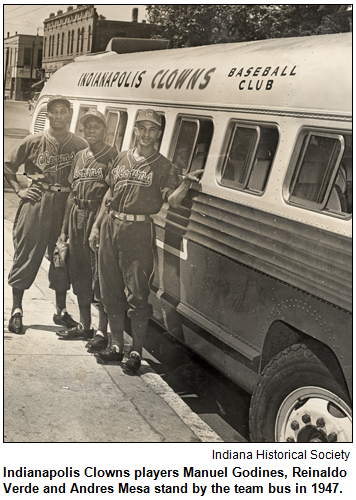 Step up to the plate for some historic baseball questions and insights. Did you know that in 1920 the very first game in the newly organized Negro Leagues was played in Indianapolis?
Step up to the plate for some historic baseball questions and insights. Did you know that in 1920 the very first game in the newly organized Negro Leagues was played in Indianapolis?
Were you aware that one of the greatest stars of the Negro Leagues - a slugger often called "the black Babe Ruth" - was an Indy native?
During an era when major league baseball was segregated, the Indianapolis Clowns and predecessor team the Indianapolis ABCs (which, as an independent team, was even competing in the early 1900s) had a huge impact.
To explore the heritage of Negro Leagues baseball in the Hoosier state, Nelson will be joined in studio by Geri Strecker, a Ball State University professor who is writing a biography of Indy native Oscar Charleston (1896-1954), an outfielder considered one of the greatest players - and, eventually, managers - in the Negro Leagues.
Nelson also will be joined by Indy native Cliff Robinson, who from ages 10 through about 14 was a batboy for the Indianapolis Clowns. Traveling with the team during the 1940s, Cliff visited nearly every major league ballpark in the country and has a mound of anecdotes.
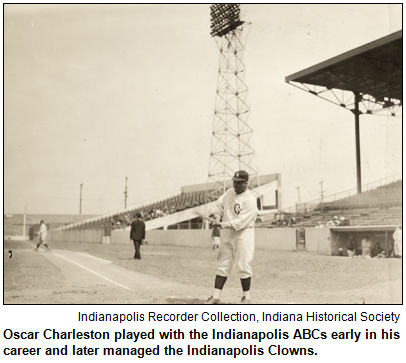 Eventually leaving the road to attend Attucks High School (class of '53) and then college, Cliff became an educator, coach and administrator at several schools before ending his career as human resources director at IUPUI.
Eventually leaving the road to attend Attucks High School (class of '53) and then college, Cliff became an educator, coach and administrator at several schools before ending his career as human resources director at IUPUI.
Our show with Cliff and Geri (who also has put together a documentary with her Ball State students about black baseball in Indiana) will air just before the 14th annual Jerry Malloy Negro Leagues Conference meets in Indy beginning Thursday July 21.
During the conference, a historical marker will be placed on the site of the first organized Negro Leagues game, which involved the Indianapolis ABCs; the site was in the former West Washington Street Park, now part of the Indianapolis Zoo. (Oscar Charleston played center field during that game.)  The former West Washington Street Park is not to be confused with Washington Park on the eastside of Indy, which, ironically, was the site of the city's former zoo.
The former West Washington Street Park is not to be confused with Washington Park on the eastside of Indy, which, ironically, was the site of the city's former zoo.
 The first game in the Negro Leagues was held in Indy partially because of the influence of Indianapolis ABCs manager (and later owner) C.I. Taylor. According to the Negro Leagues Baseball eMuseum, Taylor had "stocked the team with players of major leagues talent in 1914, and it immediately became one of the best in black baseball."
The first game in the Negro Leagues was held in Indy partially because of the influence of Indianapolis ABCs manager (and later owner) C.I. Taylor. According to the Negro Leagues Baseball eMuseum, Taylor had "stocked the team with players of major leagues talent in 1914, and it immediately became one of the best in black baseball."
Born in North Carolina, Taylor had managed a team in West Baden, Indiana; it was named the Sprudels after the mineral water at the famous hotel in the Orange County town.
In 1914, the baseball team relocated to Indianapolis and took the name ABCs in honor of its sponsor, the American Brewing Company. 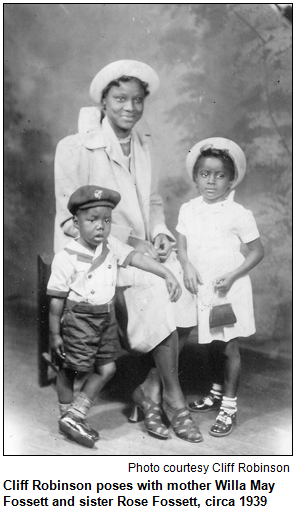 According to the Encyclopedia of Indianapolis, Taylor insisted his players wear "collars, ties and shirts when not in uniform."The ABCs players became role models for many young Hoosiers.
According to the Encyclopedia of Indianapolis, Taylor insisted his players wear "collars, ties and shirts when not in uniform."The ABCs players became role models for many young Hoosiers.
Oscar Charleston joined the team in 1915 and spent more than 30 seasons playing for or managing the ABCs or various other teams in the Negro Leagues. Some experts have called him one of the greatest (albeit unheralded) baseball players who ever lived.
Because record keeping was sketchy for the early Negro Leagues teams, comparisons are difficult. According to some accounts, though, Charleston played more than 1,000 games with a batting average of about .350. Geri says spectators even would throw money at Charleston after he made one of his spectacular plays.
Yet he died in near obscurity and was buried in Floral Park Cemetery on the Westside of Indy in 1954.
By then, the glory years of the Indianapolis Clowns also were over. The team had moved to Indy from Cincinnati during the mid-1940s. As many baseball enthusiasts know, future legend Henry Aaron made his debut with the Negro Leagues during the early 1950s with the Clowns.
As a young batboy, our guest Cliff was a roommate on the road of the flashy Clowns player “Goose” Tatum (real name: Reece Tatum), who went on to much greater fame in basketball as a Harlem Globetrotter. 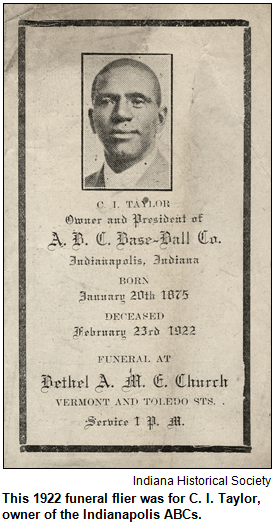 Cliff, meanwhile, grew up to become an educator, coach and administrator - and, during the late 1950s, even was an assistant trainer for the legendary Chicago Bears football team.
Cliff, meanwhile, grew up to become an educator, coach and administrator - and, during the late 1950s, even was an assistant trainer for the legendary Chicago Bears football team.
History Mystery question
He was born in North Carolina in 1956, an era when Negro Leagues baseball was fading. So he never played in the Negro Leagues, and his career in Major League baseball was not particularly significant. However, his impact in Indianapolis was spectacular. During the 1980s, he arguably became the most popular player in Indianapolis Indians history. He led the Indians to five regular-season titles in the American Association and spent a total of nine seasons with the team.
His popularity was so great that in 2006, when he was managing the Charlotte Knights, he was hailed at Victory Field with a special night designated in his honor - highly unusual for someone affiliated with an opposing team.
Question: Who is he?
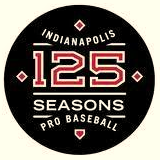 To win the prize, you must call in with the correct answer during the live show. The call-in number is (317) 788-3314, and please do not call until you hear Nelson pose the question on the air. Please do not call if you have won a prize from any WICR show during the last two months.
To win the prize, you must call in with the correct answer during the live show. The call-in number is (317) 788-3314, and please do not call until you hear Nelson pose the question on the air. Please do not call if you have won a prize from any WICR show during the last two months.
The prize is four tickets to an Indianapolis Indians game, courtesy of the Indians, as well as a one-night stay at the Omni Severin Hotel in downtown Indianapolis, courtesy of the ICVA.
Roadtrip: Wabash & Erie Canal Park in Delphi
Chris Gahl of the ICVA tells us to head northwest from Indianapolis to the city of Delphi, which is northeast of Lafayette in Carroll County. 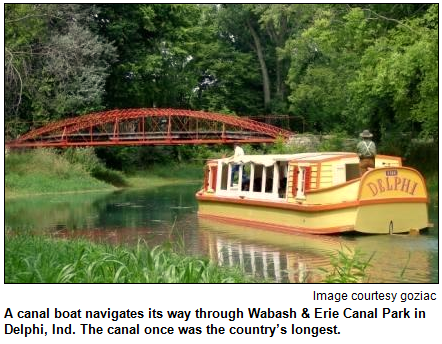 The Wabash and Erie Canal was built between 1832 and 1853 and was the country's longest canal, connecting Lake Erie at Toledo, Ohio, with the Ohio River at Evansville, Indiana.
The Wabash and Erie Canal was built between 1832 and 1853 and was the country's longest canal, connecting Lake Erie at Toledo, Ohio, with the Ohio River at Evansville, Indiana.
Delphi boasts the only watered section of the canal in Indiana. Over the past several decades the area's citizens seem to have taken their local history very seriously; creating the Wabash & Erie Canal Park. The park features more than 7.5 miles of hiking trails and an interpretive center that is open Thursday, Friday, Sunday from 1 to 4 p.m., and Saturday from 10 a.m. to 4 p.m. Admission to the interpretive center is free, and more information is available at (765) 564-2870.
Three National Register sites are located in the canal park, including an Irish workers construction campsite; Lock #33 and lockkeeper's house site; and the Harley & Hubbard Lime Kilns. Canal boat rides are also available during the summer months. Additionally, a large Wabash and Erie canal artifact from Allen County, the Gronauer Lock, is on display at the Indiana State Museum. The largely intact wooden lock was discovered by construction crews in 1991 as I-469 around Ft. Wayne was being built.
Your Hoosier History Live! team,
Nelson Price, host and creative director
Molly Head, producer, (317) 927-9101
Chris Gahl, Roadtripper
Richard Sullivan, webmaster and tech director
Pam Fraizer, graphic designer
Garry Chilluffo, creative consultant
Michele Goodrich, Jed Duvall, grant consultants
www.hoosierhistorylive.org
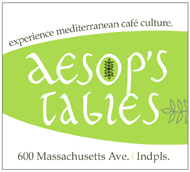




Please tell our sponsors that you appreciate their support: Aesop's Tables, Broad Ripple Brewpub, Indiana Historical Society, Lucas Oil and Story Inn.
 Acknowledgments to Print Resources, Indianapolis Marion County Public Library, Monomedia, Indiana Humanities, Indianapolis Convention & Visitors Association, WICR-FM, Fraizer Designs, Heritage Photo and Research Services, Chelsea Niccum and many other individuals and organizations. We are an independently produced program and are self-supporting through organizational sponsorships, grants and through individual tax-deductible contributions through the Indiana Humanities Council. Visit our website to learn how you can support us financially.
Acknowledgments to Print Resources, Indianapolis Marion County Public Library, Monomedia, Indiana Humanities, Indianapolis Convention & Visitors Association, WICR-FM, Fraizer Designs, Heritage Photo and Research Services, Chelsea Niccum and many other individuals and organizations. We are an independently produced program and are self-supporting through organizational sponsorships, grants and through individual tax-deductible contributions through the Indiana Humanities Council. Visit our website to learn how you can support us financially.
July 23 show
County fairs and Hoosier culture
It's a summer ritual thousands of Hoosiers crow about from Elkhart County to Delaware, Dubois and Jackson counties: Participating in - or flocking to attend - the county fair. How have these annual celebrations affected our culture across Indiana? What does “fair culture” reveal about those who participate? And do Hoosiers (as well as other Midwesterners) approach our county fairs with different expectations and enthusiasm than our counterparts in other regions of America?
Join us as we gnaw on (or savor) these questions and a cauldron of other aspects related to the fairs in Indiana's 92 counties. 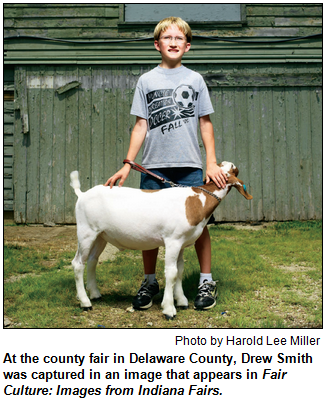 Nelson will be joined in studio by the collaborators on an upcoming visual history book titled Fair Culture: Images from Indiana Fairs (Indiana Historical Society Press).
Nelson will be joined in studio by the collaborators on an upcoming visual history book titled Fair Culture: Images from Indiana Fairs (Indiana Historical Society Press).
Among our guests will be Harold Lee Miller, an Indianapolis-based photographer who began taking pictures of 4-H participants at the poultry and rabbit barns of the Indiana State Fair. Then Harold "branched out" to photograph people and activities at county fairs across the state. Fair Culture features more than 100 of his images; they depict everything from sheep and cattle to antics on the midways.
Nelson and Harold will be joined by Gerald Waite, a lecturer emeritus at Ball State University who was an anthropology instructor. His essay accompanies Harold's photos in Fair Culture and explores the history of fairs from the Middle Ages to contemporary times; it also delves into the growth of Indiana county fairs. Fun facts: This year's Marion County Fair will be the 81st; it kicks off July 21.
© 2011 Hoosier History Live! All rights reserved.